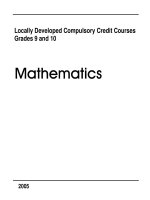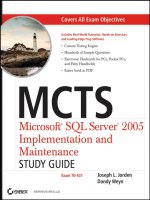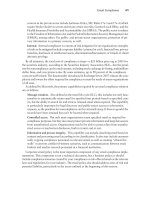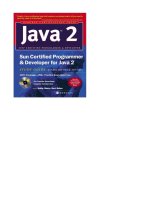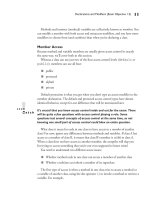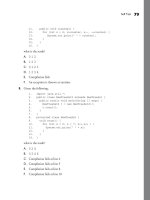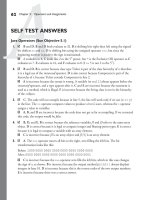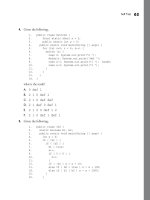sun certified security administrator for solaris 9 and 10 study guide
Bạn đang xem bản rút gọn của tài liệu. Xem và tải ngay bản đầy đủ của tài liệu tại đây (10.79 MB, 577 trang )
TEAM LinG
Sun
®
Certified Security
Administrator for Solaris
™
9 & 10 Study Guide
TEAM LinG
This page intentionally left blank
TEAM LinG
Sun
®
Certified Security
Administrator for Solaris
™
9 & 10 Study Guide
John Chirillo
Edgar Danielyan
McGraw-Hill/Osborne
New York Chicago San Francisco Lisbon London Madrid
Mexico City Milan New Delhi San Juan Seoul Singapore Sydney Toronto
McGraw-Hill/Osborne is an independent entity from Sun Microsystems, Inc. and is
not affiliated with Sun Microsystems, Inc. in any manner. This publication and CD may
be used in assisting students to prepare for the Sun Certified Security Administrator
Exam. Neither Sun Microsystems nor McGraw-Hill/Osborne warrant that use of this
publication and CD will ensure passing the relevant exam. Solaris, Sun Microsystems,
and the Sun Logo are trademarks or registered trademarks of Sun Microsystems, Inc.
in the United States and other countries.
TEAM LinG
Copyright © 2005 by The McGraw-Hill Companies. All rights reserved. Manufactured in the United States of America. Except as per-
mitted under the United States Copyright Act of 1976, no part of this publication may be reproduced or distributed in any form or by
any means, or stored in a database or retrieval system, without the prior written permission of the publisher.
0-07-226450-0
The material in this eBook also appears in the print version of this title: 0-07-225423-8.
All trademarks are trademarks of their respective owners. Rather than put a trademark symbol after every occurrence of a
trademarked name, we use names in an editorial fashion only, and to the benefit of the trademark owner, with no intention of
infringement of the trademark. Where such designations appear in this book, they have been printed with initial caps.
McGraw-Hill eBooks are available at special quantity discounts to use as premiums and sales promotions, or for use in corporate train-
ing programs. For more information, please contact George Hoare, Special Sales, at or (212) 904-4069.
TERMS OF USE
This is a copyrighted work and The McGraw-Hill Companies, Inc. (“McGraw-Hill”) and its licensors reserve all rights in and to the
work. Use of this work is subject to these terms. Except as permitted under the Copyright Act of 1976 and the right to store and retrieve
one copy of the work, you may not decompile, disassemble, reverse engineer, reproduce, modify, create derivative works based upon,
transmit, distribute, disseminate, sell, publish or sublicense the work or any part of it without McGraw-Hill’s prior
consent. You may use the work for your own noncommercial and personal use; any other use of the work is strictly prohibited. Your right
to use the work may be terminated if you fail to comply with these terms.
THE WORK IS PROVIDED “AS IS.” McGRAW-HILL AND ITS LICENSORS MAKE NO GUARANTEES OR WARRANTIES AS
TO THE ACCURACY, ADEQUACY OR COMPLETENESS OF OR RESULTS TO BE OBTAINED FROM USING THE WORK,
INCLUDING ANY INFORMATION THAT CAN BE ACCESSED THROUGH THE WORK VIA HYPERLINK OR
OTHERWISE, AND EXPRESSLY DISCLAIM ANY WARRANTY, EXPRESS OR IMPLIED, INCLUDING BUT NOT
LIMITED TO IMPLIED WARRANTIES OF MERCHANTABILITY OR FITNESS FOR A PARTICULAR PURPOSE.
McGraw-Hill and its licensors do not warrant or guarantee that the functions contained in the work will meet your requirements or that
its operation will be uninterrupted or error free. Neither McGraw-Hill nor its licensors shall be liable to you or anyone else for any inac-
curacy, error or omission, regardless of cause, in the work or for any damages resulting therefrom. McGraw-Hill has no responsibility
for the content of any information accessed through the work. Under no circumstances shall McGraw-Hill and/or its licensors be liable
for any indirect, incidental, special, punitive, consequential or similar damages that result from the use of or
inability to use the work, even if any of them has been advised of the possibility of such damages. This limitation of liability shall apply
to any claim or cause whatsoever whether such claim or cause arises in contract, tort or otherwise.
DOI: 10.1036/0072254238
TEAM LinG
ABOUT THE CONTRIBUTORS
About the Author
John Chirillo, CISSP, ISSAP, ASE, CCDA, CCNA, CCNP, SCSECA, is a Senior
Internetworking Engineer at ValCom and the author of several computer security
books. John has also achieved certifications in numerous programming languages and
is responsible for dozens of published security exploits and alerts throughout numerous
listings. He has actively participated in core security developments of various UNIX
flavors under the GNU. John can be reached at
About the Co-Author
Edgar Danielyan, CISSP, ISSAP, ISSMP, CISA, MBCS, SCSA, SCNA, is Information
Systems Audit Manager with Deloitte & Touche in the city of London. Before joining
Deloitte, he had been an independent security consultant since 1999. He is also the
author of Solaris 8 Security (New Riders, 2001) and technical editor of a number of
books on Solaris, security, UNIX, and internetworking. His personal web site can be
found at www.danielyan.com.
About the Technical Editor
Tom Brays, SCSA, SCNA, SCSECA, MCP, is a network administrator for a large
telecommunications firm and the technical editor and contributing author of several
computer books. He can be reached at
About LearnKey
LearnKey provides self-paced learning content and multimedia delivery solutions to
enhance personal skills and business productivity. LearnKey claims the largest library
of rich streaming-media training content that engages learners in dynamic media-
rich instruction complete with video clips, audio, full motion graphics, and animated
illustrations. LearnKey can be found on the Web at www.LearnKey.com.
Copyright © 2005 by The McGraw-Hill Companies. Click here for terms of use.
TEAM LinG
This page intentionally left blank
TEAM LinG
vii
CONTENTS AT A GLANCE
Part I
General Security Concepts
1 Fundamental Security Concepts . . . . . . . . . . . . . . . . . . . . . . . . . . . 3
2 Attacks, Motives, and Methods . . . . . . . . . . . . . . . . . . . . . . . . . . . . 35
3 Security Management and Standards . . . . . . . . . . . . . . . . . . . . . . . . 65
Part II
Detection and Device Management
4 Logging and Process Accounting . . . . . . . . . . . . . . . . . . . . . . . . . . . 95
5 Solaris Auditing, Planning, and Management . . . . . . . . . . . . . . . . . . 121
6 Device, System, and File Security . . . . . . . . . . . . . . . . . . . . . . . . . . 151
Part III
Security Attacks
7 Denial of Service Attacks . . . . . . . . . . . . . . . . . . . . . . . . . . . . . . . . 179
8 Remote Access Attacks . . . . . . . . . . . . . . . . . . . . . . . . . . . . . . . . . . 217
Part IV
File and System Resources Protection
9 User and Domain Account Management with RBAC . . . . . . . . . . . . 255
10 Fundamentals of Access Control . . . . . . . . . . . . . . . . . . . . . . . . . . . 281
Part V
Solaris Cryptographic Framework
11 Using Cryptographic Services . . . . . . . . . . . . . . . . . . . . . . . . . . . . . 305
TEAM LinG
viii
Sun Certified Security Administrator for Solaris 9 & 10 Study Guide
Part VI
Authentication Services and Secure Communication
12 Secure RPC Across NFS and PAM . . . . . . . . . . . . . . . . . . . . . . . . . 333
13 SASL and Secure Shell . . . . . . . . . . . . . . . . . . . . . . . . . . . . . . . . . . 355
14 Sun Enterprise Authentication Mechanism . . . . . . . . . . . . . . . . . . . 375
Part VII
Appendixes
A Final Test Study Guide . . . . . . . . . . . . . . . . . . . . . . . . . . . . . . . . . . 423
B Final Test . . . . . . . . . . . . . . . . . . . . . . . . . . . . . . . . . . . . . . . . . . . . 447
C Final Test Answers . . . . . . . . . . . . . . . . . . . . . . . . . . . . . . . . . . . . . 475
D Hands-On Exercises and Solutions . . . . . . . . . . . . . . . . . . . . . . . . . . 499
Index . . . . . . . . . . . . . . . . . . . . . . . . . . . . . . . . . . . . . . . . . . . . . . . 515
TEAM LinG
ix
CONTENTS
About the Contributors . . . . . . . . . . . . . . . . . . . . . . . . . . . . . . . v
Acknowledgments . . . . . . . . . . . . . . . . . . . . . . . . . . . . . . . . . . xvii
Preface . . . . . . . . . . . . . . . . . . . . . . . . . . . . . . . . . . . . . . . . xix
Introduction . . . . . . . . . . . . . . . . . . . . . . . . . . . . . . . . . . . . . xxiii
Part I
General Security Concepts
1 Fundamental Security Concepts . . . . . . . . . . . . . . . . 3
Describe Principles of Information Security 4
Confidentiality 4
Integrity 5
Availability 5
Identification 6
Authentication 6
Authorization 8
Accountability 8
Logs 9
Functionality vs. Assurance 9
Privacy 10
Non-repudiation 10
Explain Information Security Fundamentals
and Define Good Security Architectures 13
Least Privilege 13
Defense in Depth 13
Minimization 14
Cost-Benefit Analysis 14
Risk-Control Adequacy 14
Compartmentalization 15
Keep Things Simple 15
For more information about this title, click here
TEAM LinG
x
Sun Certified Security Administrator for Solaris 9 & 10 Study Guide
Fail Securely 15
Secure the Weakest Link 16
Use Choke Points 16
Leverage Unpredictability 16
Segregation of Duties 16
Types of Controls 17
Access Control Models 18
Information Security Architectures 20
✓ Two-Minute Drill 26
Q&A Self Test 27
Self Test Answers 32
2 Attacks, Motives, and Methods . . . . . . . . . . . . . . . . . . 35
Describe Concepts of Insecure Systems, User Trust,
Threat, and Risk 36
Trust 38
Threats 39
Vulnerabilities 39
Risks and Risk Management 40
Explain Attackers, Motives, and Methods 43
Types of Attackers 44
Attack Motives 46
Attack Methods 46
Describe How Attackers Gain Information,
and Describe Methods to Reduce Disclosure 51
Top 10 UNIX Vulnerabilities 54
✓ Two-Minute Drill 56
Q&A Self Test 58
Self Test Answers 62
3 Security Management and Standards . . . . . . . . . . . . . 65
Identify the Security Life Cycle
and Describe Best Security Practices 66
Security Management and Operations 66
Security Life Cycle 67
Security Awareness 69
Security Policies, Procedures, and Guidelines 69
Physical Security 71
TEAM LinG
Contents
xi
Platform Security 72
Network Security 73
Applications Security 76
Describe the Benefits of Evaluation Standards 77
The Common Criteria (ISO 15408) 77
ISO 17799 79
Certification, Evaluation, and Accreditation 81
✓ Two-Minute Drill 83
Q&A Self Test 85
Self Test Answers 89
Part II
Detection and Device Management
4 Logging and Process Accounting . . . . . . . . . . . . . . . . 95
Identify, Monitor, and Disable Logins 96
Identifying, Disabling, and Monitoring Logins 98
Configure syslog, Customize the System Logging Facility,
and Monitor and Control Superuser 106
Configuring syslog and Customizing the
System Logging Facility 106
Monitoring and Controlling Superuser Access 109
✓ Two-Minute Drill 111
Q&A Self Test 113
Lab Question 115
Self Test Answers 116
Lab Answer 118
5 Solaris Auditing, Planning, and Management . . . . . . . 121
Configure Solaris Auditing and Customize Audit Events 122
Solaris Auditing 123
Generate an Audit Trail and Analyze the Audit Data 136
✓ Two-Minute Drill 139
Q&A Self Test 141
Lab Question 144
Self Test Answers 145
Lab Answer 148
TEAM LinG
xii
Sun Certified Security Administrator for Solaris 9 & 10 Study Guide
6 Device, System, and File Security . . . . . . . . . . . . . . . . 151
Control Access to Devices by Configuring
and Managing Device Policy and Device Allocation 152
Device Policy 152
Device Allocation 157
Use the Basic Audit Reporting Tool to Create a Manifest
and Check System Integrity . 162
Creating a Manifest 162
Comparing Manifests 165
✓ Two-Minute Drill 167
Q&A Self Test 169
Lab Question 171
Self Test Answers 172
Lab Answer 174
Part III
Security Attacks
7 Denial of Service Attacks . . . . . . . . . . . . . . . . . . . . . . 179
Differentiate Between the Types of Host-Based Denial of
Service Attacks and Understand How Attacks Are Executed 180
Program Buffer Overflow 181
Malformed Packet Attacks and Flooding 183
Establish Courses of Action to Prevent Denial of Service Attacks 194
Preventing Stack-Based Buffer Overflow Attacks 195
Preventing General DoS Attacks, Malformed
Packet Attacks, and Flooding 197
✓ Two-Minute Drill 207
Q&A Self Test 209
Lab Question 212
Self Test Answers 213
Lab Answer 216
8 Remote Access Attacks . . . . . . . . . . . . . . . . . . . . . . . . 217
Identify, Detect, and Protect Against Trojan Horse Programs
and Backdoors 218
Securing the System from Trojans and Backdoors 219
TEAM LinG
Contents
xiii
Explain Rootkits that Exploit Loadable Kernel Modules 236
Rootkits and Loadable Kernel Modules 237
✓ Two-Minute Drill 240
Q&A Self Test 243
Lab Question 246
Self Test Answers 247
Lab Answer 250
Part IV
File and System Resources Protection
9 User and Domain Account Management
with RBAC . . . . . . . . . . . . . . . . . . . . . . . . . . . . . . . . 255
Describe the Benefits and Capabilities of Role-Based
Access Control (RBAC) 256
Authorization 257
Privilege 258
Privileged Application 260
Rights Profile 260
Role 260
Explain How to Configure and Audit Role-Based Access
Control (RBAC) 261
Managing Rights and Roles 262
✓ Two-Minute Drill 270
Q&A Self Test 272
Lab Question 275
Self Test Answers 276
Lab Answer 279
10 Fundamentals of Access Control . . . . . . . . . . . . . . . . 281
Use UNIX Permissions to Protect Files 282
Listing and Securing Files and Directories 283
Use Access Control Lists to Set File Permissions 293
Working with ACLs 294
✓ Two-Minute Drill 296
Q&A Self Test 297
TEAM LinG
xiv
Sun Certified Security Administrator for Solaris 9 & 10 Study Guide
Lab Question 298
Self Test Answers 299
Lab Answer 301
Part V
Solaris Cryptographic Framework
11 Using Cryptographic Services . . . . . . . . . . . . . . . . . . 305
Explain How to Protect Files Using the
Solaris Cryptographic Framework 307
Generating Symmetric Keys 307
Ensuring the Integrity of Files Using Checksum 308
Protecting Files with a Message
Authentication Code (MAC) 312
Encrypting and Decrypting Files 314
Administer the Solaris Cryptographic Framework 315
Listing Available Providers 315
Preventing the Use of a User-Level Mechanism 318
✓ Two-Minute Drill 321
Q&A Self Test 323
Lab Question 325
Self Test Answers 326
Lab Answer 328
Part VI
Authentication Services and Secure Communication
12 Secure RPC Across NFS and PAM . . . . . . . . . . . . . . . 333
Explain and Configure Secure RPC to Authenticate a Host
and a User Across an NFS Mount 334
Generating the Public and Secret Keys 335
Configuring Secure RPC for NIS, NIS+, and NFS 338
Use the PAM Framework to Configure the Use of System
Entry Services for User Authentication 341
Planning for PAM Implementation 342
✓ Two-Minute Drill 346
Q&A Self Test 349
TEAM LinG
Contents
xv
Lab Question 350
Self Test Answers 351
Lab Answer 352
13 SASL and Secure Shell . . . . . . . . . . . . . . . . . . . . . . . . 355
Explain the Simple Authentication and Security Layer (SASL)
in Solaris 356
SASL Overview and Introduction 356
Use Solaris Secure Shell to Access a Remote Host Securely Over
an Unsecured Network 358
Solaris Secure Shell Authentication 359
Using Solaris Secure Shell—Key Generation 360
✓ Two-Minute Drill 367
Q&A Self Test 369
Lab Question 370
Self Test Answers 371
Lab Answer 374
14 Sun Enterprise Authentication Mechanism . . . . . . . . 375
Define the Sun Enterprise Authentication Mechanism
and Configuration Issues 376
How SEAM Works 376
SEAM Preconfiguration Planning 379
Configure and Administer the Sun Enterprise
Authentication Mechanism 384
Configuring KDC Servers 385
Configuring Cross-Realm Authentication 393
Configuring SEAM Network Application Servers 396
Configuring SEAM NFS Servers 398
Configuring SEAM Clients 401
Synchronizing Clocks Between KDCs and SEAM Clients 403
Increasing Security 404
✓ Two-Minute Drill 406
Q&A Self Test 409
Lab Question 410
Self Test Answers 411
Lab Answer 413
TEAM LinG
xvi
Sun Certified Security Administrator for Solaris 9 & 10 Study Guide
Part VII
Appendixes
A Final Test Study Guide . . . . . . . . . . . . . . . . . . . . . . . . . 423
B Final Test . . . . . . . . . . . . . . . . . . . . . . . . . . . . . . . . . . . 447
C Final Test Answers . . . . . . . . . . . . . . . . . . . . . . . . . . . . 475
D Hands-On Exercises and Solutions . . . . . . . . . . . . . . . 499
Exercises . . . . . . . . . . . . . . . . . . . . . . . . . . . . . . . . . . . . . . . . . . . . 500
Solutions . . . . . . . . . . . . . . . . . . . . . . . . . . . . . . . . . . . . . . . . . . . . 502
Index . . . . . . . . . . . . . . . . . . . . . . . . . . . . . . . . . . . . . . 515
TEAM LinG
xvii
ACKNOWLEDGMENTS
W
e would like to thank the following people:
■ Everyone at Osborne: Tim Green, Jody McKenzie, Jane Brownlow,
Jennifer Housh, and Jessica Wilson for all their hard work.
■ The best literary agent in the business, David Fugate at Waterside.
■ The fine people at Sun Microsystems for their support and contributions,
especially contributing authors Stephen Moore and Tom Brays.
■ Our families for their unconditional love, support, and understanding especially
during those endless evenings.
Copyright © 2005 by The McGraw-Hill Companies. Click here for terms of use.
TEAM LinG
This page intentionally left blank
TEAM LinG
xix
PREFACE
T
his book is organized in such a way as to serve as an in-depth review for the
Sun Certified Security Administrator for the Solaris Operating System 9 and 10
certifications for candidates with 6 to 12 months of experience administering security
in a Solaris Operating System. Each chapter covers a major aspect of the exam, with an emphasis
on the “why” as well as the “how to” of working with, and supporting, Solaris 9 and 10 as a security
administrator or engineer.
On the CD
The CD-ROM contains interactive study tools and a repository of online study
material, including web-based ePractice exams and the Sun Career Accelerator
Packages.
Exam Readiness Checklist
At the end of the Introduction, you will find an Exam Readiness Checklist. This table
has been constructed to allow you to cross-reference the official exam objectives with
the objectives as they are presented and covered in this book. The checklist also allows
you to gauge your level of expertise on each objective at the outset of your studies.
This should allow you to check your progress and make sure you spend the time you
need on more difficult or unfamiliar sections. References have been provided for the
objective exactly as the vendor presents it, the section of the study guide that covers
that objective, and a chapter and page reference.
In Every Chapter
We’ve created a set of chapter components that call your attention to important items,
reinforce important points, and provide helpful exam-taking hints. Take a look at what
you’ll find in every chapter:
■ Every chapter begins with the Certification Objectives—what you need to
know in order to pass the section on the exam dealing with the chapter topic.
Copyright © 2005 by The McGraw-Hill Companies. Click here for terms of use.
TEAM LinG
xx
Sun Certified Security Administrator for Solaris 9 & 10 Study Guide
The Objective headings identify the objectives within the chapter, so you’ll
always know an objective when you see it!
■ Exam Watch notes call attention to information about, and potential pitfalls in,
the exam. These helpful hints are written by authors who have taken the exams
and received their certification. (Who better to tell you what to worry about?)
They know what you’re about to go through!
■ Practice Exercises are interspersed throughout the chapters. These are step-
by-step exercises that allow you to get the hands-on experience you need in
order to pass the exams. They help you master skills that are likely to be an
area of focus on the exam. Don’t just read through the exercises; they are
hands-on practice that you should be comfortable completing. Learning by
doing is an effective way to increase your competency with a product.
■ On the Job notes describe the issues that come up most often in real-world
settings. They provide a valuable perspective on certification- and product-
related topics. They point out common mistakes and address questions that
have arisen during on-the-job discussions.
■ Inside the Exam sidebars highlight some of the most common and confusing
problems that students encounter when taking a live exam. Designed to
anticipate what the exam will emphasize, getting inside the exam will help
ensure you know what you need to know to pass the exam. You can get a leg
up on how to respond to those difficult-to-understand questions by focusing
extra attention on these sidebars.
■ The Certification Summary is a succinct review of the chapter and
a restatement of salient points regarding the exam.
■ The Two-Minute Drill at the end of every chapter is a checklist of the main
points of the chapter. It can be used for last-minute review.
■ The Self Test offers questions similar to those found on the certification exams.
The answers to these questions, as well as explanations of the answers, can be
found at the end of each chapter. By taking the Self Test after completing each
chapter, you’ll reinforce what you’ve learned from that chapter while becoming
familiar with the structure of the exam questions.
■ The Lab Question at the end of the Self Test section offers a unique and
challenging question format that requires the reader to understand multiple
chapter concepts to answer correctly. These questions are more complex and
TEAM LinG
Preface
xxi
more comprehensive than the other questions, as they test your ability to
take all the knowledge you have gained from reading the chapter and apply
it to complicated, real-world situations. These questions are aimed to be
more difficult than what you will find on the exam. If you can answer these
questions, you have proven that you know the subject!
Some Pointers
Once you’ve finished reading this book, set aside some time to do a thorough review.
You might want to return to the book several times and make use of all the methods it
offers for reviewing the material. The following are some suggested methods of review.
1. Re-read all the Two-Minute Drills, or have someone quiz you. You also can use
the drills as a way to do a quick cram before the exam. You might want to take
some 3×5 index cards and write Two-Minute Drill material on them to create
flash cards.
2. Re-read all the Exam Watch notes. Remember that these notes are written by
authors who have taken the exam and passed. They know what you should
expect—and what you should be on the lookout for.
3. Retake the Self Tests. Taking the tests right after you’ve read the chapter is a good
idea because the questions help reinforce what you’ve just learned. However,
it’s an even better idea to go back later and do all the questions in the book in
one sitting. In this instance, pretend you’re taking the live exam. (When you go
through the questions the first time, mark your answers on a separate piece of
paper. That way, you can run through the questions as many times as you need
to until you feel comfortable with the material.)
4. Complete the Exercises. Did you do the exercises when you read through each
chapter? If not, do them! These exercises are designed to cover exam topics,
and there’s no better way to get to know this material than by practicing.
Be sure you understand why you’re performing each step in each exercise.
If there’s something you’re not clear on, re-read that section in the chapter.
5. Review the Final Test Study Guide and take the Final Test in the appendixes. You
should retake this test until you can answer all questions correctly before taking
Sun’s exam.
TEAM LinG
This page intentionally left blank
TEAM LinG
xxiii
INTRODUCTION
T
he Sun Certified Security Administrator for the Solaris Operating System exam is for
those candidates with 6 to 12 months of experience administering security in a Solaris
Operating System (Solaris OS). It is recommended that candidates have at least 6 to
12 months security administration job-role experience and have previous Solaris OS and network
administration certification.
About the Exam
The examination will include multiple choice scenario-based questions, matching,
drag-drop, and free-response question types and will require in-depth knowledge on
security topics such as general security concepts, detection and device management,
security attacks, file and system resources protection, host and network prevention,
network connection access, authentication, and encryption.
Testing Objectives
Working with Sun, we put together the following general collective testing
objectives—all contained in this book—which cover the material for both Sun
Certified Security Administrator for the Solaris 9 and 10 Operating System exams:
Section 1: Fundamental Security Concepts
■ Describe accountability, authentication, authorization, privacy, confidentiality,
integrity, and non-repudiation
■ Explain fundamental concepts concerning information security and explain
what good security architectures include (people, process, technology, defense
in depth)
Section 2: Attacks, Motives, and Methods
■ Describe concepts of insecure systems, user trust, threat, and risk
■ Explain attackers, motives, and methods
■ Describe how the attackers gain information about the targets and describe
methods to reduce disclosure of revealing information
Copyright © 2005 by The McGraw-Hill Companies. Click here for terms of use.
TEAM LinG
xxiv
Sun Certified Security Administrator for Solaris 9 & 10 Study Guide
Section 3: Security Management and Standards
■ Identify the security life cycle (prevent, detect, react, and deter) and
describe security awareness, security policies and procedures, physical
security, platform security, network security, application security, and security
operations and management
■ Describe the benefits of evaluation standards
Section 4: Logging and Process Accounting
■ Identify, monitor, and disable logins
■ Configure syslog, customize the system logging facility, and monitor and
control superuser
Section 5: Solaris Auditing, Planning, and Management
■ Configure Solaris auditing and customize audit events
■ Generate an audit trail and analyze the audit data
Section 6: Device, System, and File Security
■ Control access to devices by configuring and managing device policy and
allocation
■ Use the Basic Audit Reporting Tool to create a manifest of every file installed
on the system and check the integrity of the system
Section 7: Denial of Service Attacks
■ Differentiate between the types of host-based denial of service attacks and
understand how attacks are executed
■ Establish courses of action to prevent denial of service attacks
Section 8: Remote Access Attacks
■ Identify, detect, and protect against Trojan horse programs and backdoors
■ Explain rootkits that exploit loadable kernel modules
Section 9: User and Domain Account Management with RBAC
■ Describe the benefits and capabilities of Role-Based Access Control (RBAC)
■ Explain how to configure and audit RBAC
Section 10: Fundamentals of Access Control
■ Use UNIX permissions to protect files
■ Use access control lists to set file permissions
TEAM LinG
